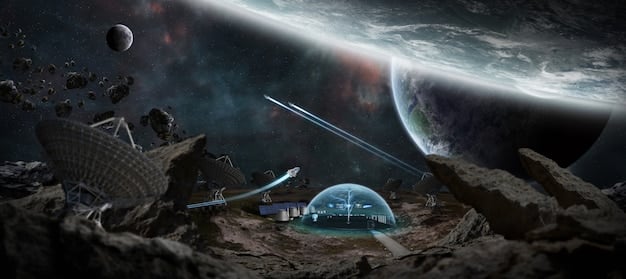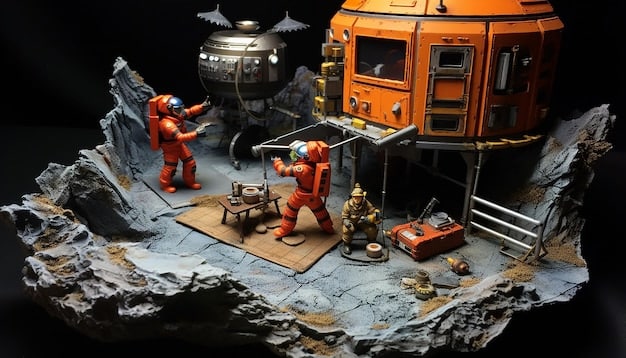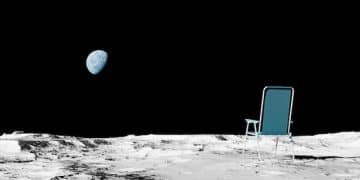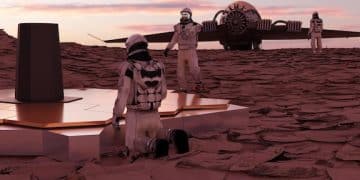NASA’s Lunar Future: Key Technologies for Habitation by 2030

NASA is prioritizing three pivotal technologies—In-Situ Resource Utilization (ISRU), advanced manufacturing and robotics, and sophisticated closed-loop life support systems—to establish sustainable lunar surface habitation within the next five years, crucial for future deep-space missions and scientific endeavors.
The dawn of a new era in space exploration is upon us, with humanity setting its sights firmly on a sustained presence beyond Earth. Central to this ambitious vision is the question of how we will live and thrive on celestial bodies, particularly the Moon. To answer this, we need to discover the 3 key technologies NASA is prioritizing for lunar surface habitation in the next 5 years, paving the way for a permanent return to our closest celestial neighbor.
The Imperative of Lunar Habitation: Why Now?
The push for lunar habitation isn’t merely about planting flags; it’s a strategic move to unlock unprecedented scientific discovery and prepare for even grander voyages into deep space, including Mars. Establishing a sustainable human presence on the Moon serves as a critical testbed for technologies and operational procedures that will be indispensable for future planetary exploration.
Beyond scientific inquiry, a lunar outpost could accelerate commercial space activities. Imagine lunar mining operations providing resources for construction both on the Moon and in Earth orbit, or a lunar tourism industry taking root. This forward-looking perspective underscores the multifaceted benefits of prioritizing lunar infrastructure development. The challenges are enormous, ranging from extreme temperatures and radiation to the pervasive lunar dust, but the potential rewards are equally vast.
Strategic Goals and Lunar Bases
NASA’s Artemis program embodies this ambition, aiming not just for human footprints but for long-term lunar presence. This involves building habitats that are resilient, self-sufficient, and scalable. The foundational goal is to learn how to live and work sustainably on another planetary body before embarking on even more complex missions to Mars. This approach minimizes risks and maximizes the chance of success for future human expeditions.
- Resource Independence: Reducing reliance on Earth for supplies.
- Scientific Outposts: Enabling continuous research in astronomy, geology, and biology.
- Gateway to Mars: Utilizing the Moon as a staging point for deep-space missions.
The strategic deployment of cutting-edge technologies is paramount to achieving these objectives. Each technological advancement brings us closer to a future where humanity’s reach extends far beyond the confines of Earth, establishing permanent footholds in the cosmos.
In-Situ Resource Utilization (ISRU): Living Off the Land
The concept of In-Situ Resource Utilization, or ISRU, is perhaps the most revolutionary and fundamentally critical technology for sustained lunar habitation. It’s the ability to “live off the land” – using local resources found on the Moon to produce everything from water and oxygen to building materials and rocket fuel. Without ISRU, any lunar base would be prohibitively expensive to maintain, requiring constant resupply from Earth.
The moon is not barren; it contains vast quantities of regolith, a layer of loose, unconsolidated dust and rocks. This regolith is rich in useful minerals, including oxides that can be broken down to extract oxygen. Crucially, polar regions of the moon are believed to harbor significant ice deposits within permanently shadowed craters. This ice is a game-changer, as it can be melted and purified to provide drinking water, breathable oxygen, and, perhaps most importantly, hydrogen and oxygen propellants for rockets.
Extracting Vital Resources from Regolith and Ice
NASA is heavily investing in technologies to efficiently extract these resources. For oxygen production from regolith, systems are being developed that heat lunar soil to extremely high temperatures, often using microwave energy or concentrated solar power, to liberate oxygen molecules from mineral oxides like ilmenite. The leftover metallic byproducts could potentially be used in other manufacturing processes.
- Oxygen Extraction: From lunar regolith (e.g., ilmenite reduction).
- Water Ice Mining: From permanently shadowed regions at the lunar poles.
- Propellant Production: Combining extracted hydrogen and oxygen for rocket fuel.
Water ice holds immense promise. Technologies for excavating and processing this ice are complex, requiring robust rovers and specialized equipment capable of operating in the extreme cold and darkness of shadowed craters. Once extracted, the ice can be heated to produce water vapor, which is then condensed into liquid water. This water can be used directly for consumption, hygiene, and plant cultivation, or electrolyzed to produce hydrogen and oxygen.
The ability to produce propellants on the Moon is transformative. It fundamentally changes the economics of space travel, allowing missions to refuel at a lunar depot before heading to Mars or other destinations. This lunar “gas station” concept drastically reduces the mass that needs to be launched from Earth, making deep-space exploration much more feasible and affordable.

The development of efficient and reliable ISRU systems is a monumental engineering challenge. These systems must be compact, robust enough to withstand the harsh lunar environment, and capable of operating with minimal human intervention. Research focuses on optimizing energy consumption, enhancing reliability, and scaling operations to meet the needs of a growing lunar outpost. The success of ISRU will determine the long-term viability and self-sufficiency of humanity’s lunar presence, moving us from mere visitors to permanent residents.
Advanced Manufacturing and Robotics: Building a Lunar Future
Establishing a permanent presence on the Moon necessitates the ability to build and maintain structures, equipment, and even spare parts directly on-site, rather than shipping everything from Earth. This is where advanced manufacturing and robotics play a pivotal role. These technologies are foundational to reducing mission costs, enhancing autonomy, and enabling the rapid expansion of lunar infrastructure. NASA’s focus is on developing 3D printing capabilities and highly autonomous robotic systems that can operate with minimal human oversight.
Imagine printing a habitat module from lunar dust, or fabricating a replacement part for a life support system on demand. This “manufacturing in space” paradigm is a game-changer. 3D printing, or additive manufacturing, is particularly well-suited for the lunar environment. It minimizes waste, uses local materials (lunar regolith), and allows for the creation of complex geometries and custom parts. Research includes developing specific lunar regolith simulants to test printer designs and processes, ensuring the printed structures are strong, durable, and radiation-resistant.
Robots as Builders and Maintainers
Robotic systems are the unblinking, tireless workforces of the lunar frontier. These aren’t just rovers; they are multi-functional machines designed for tasks ranging from site preparation and construction to inspection and repair. Their autonomy is key, allowing them to perform complex operations without constant real-time commands from Earth, where communication delays can be significant.
- Autonomous Construction: Robots building habitats, landing pads, and infrastructure.
- On-Demand Part Fabrication: 3D printing spare parts and tools from local materials.
- Infrastructure Maintenance: Robots inspecting and repairing systems without human intervention.
NASA is exploring various types of construction robots, including those that can lay down layers of regolith for structures, compact surfaces for landing pads, or even deploy solar arrays. These robots must be equipped with sophisticated navigation, sensing, and manipulation capabilities. The goal is to move beyond simple teleoperation to true autonomy, where robots can assess situations, make decisions, and execute tasks independently, reporting back only on their progress or when critical issues arise.
The integration of advanced manufacturing with robotics creates a powerful synergy. Robots can collect and process lunar regolith, feed it into 3D printers, and then assemble the printed components into larger structures. This closed-loop system of resource utilization, manufacturing, and construction dramatically reduces the logistical burden from Earth. Furthermore, these systems are critical for maintaining habitats and equipment, ensuring the longevity and safety of human operations in an unforgivable environment. The next five years will see significant strides in demonstrating these capabilities, bringing us closer to a self-sufficient lunar outpost.
Closed-Loop Life Support Systems: Sustaining Human Life
While ISRU provides resources and advanced manufacturing builds habitats, it is the closed-loop life support system (CLLS) that directly sustains human life within those habitats. These systems are designed to recycle almost everything an astronaut needs to survive: air, water, and waste. On Earth, we take these resources for granted, but in the hostile environment of the Moon, every drop of water and every breath of air must be carefully managed and reused. This technology is critical for long-duration missions, as it drastically reduces the resupply mass from Earth, which is both expensive and complex.
A truly closed-loop system aims for near-total recycling efficiency, minimizing the need for new inputs. For water, this means purifying urine, sweat, and condensation from the air into potable water. For air, it involves removing carbon dioxide exhaled by astronauts and regenerating oxygen. Solid waste management, including food scraps and fecal matter, also needs to be addressed through biological or thermal processing to recover resources or dispose of waste safely.
Components of a Regenerative System
NASA’s research in CLLS focuses on several integrated components. The Environmental Control and Life Support System (ECLSS) on the International Space Station (ISS) is a current example of a partially closed-loop system, demonstrating the feasibility of many of these technologies. However, lunar applications require even greater efficiency and reliability due to the extended mission durations and limited resupply options.
- Water Recovery: Advanced filtration and processing of wastewater, including urine and humidity.
- Atmospheric Regulation: Carbon dioxide removal and oxygen generation (e.g., using Sabatier reactors or electrolysis).
- Waste Management: Processing of solid waste for resource recovery or safe disposal.
Water recovery systems are vital. Technologies like water filters, vapor compression distillation, and osmotic processes are continuously being refined to achieve higher recovery rates and produce water clean enough for drinking and hygiene. Atmospheric regulation involves systems that absorb CO2, often using chemical sorbents, and then regenerate oxygen from that CO2, perhaps through processes like the Sabatier reaction, which uses hydrogen to convert carbon dioxide into water and methane, or through electrolysis of recycled water.
Beyond the physical and chemical processes, biological components are also being explored. Hydroponics and aeroponics could allow for on-site food production, recycling wastewater and producing oxygen as a byproduct, further closing the loop. Such bio-regenerative systems offer a degree of self-sufficiency that purely mechanical systems cannot. The integration of all these elements into a reliable, efficient, and robust system is a major technological hurdle. Ensuring these systems are compact, lightweight, and capable of autonomous operation for years without failure is paramount to supporting human life safely and sustainably on the lunar surface.
Autonomous Systems and AI Integration: The Smart Lunar Base
The success of any long-term lunar habitation effort, particularly one aiming for a five-year timeline, relies heavily on the integration of autonomous systems and artificial intelligence (AI). Given the significant communication delays between Earth and the Moon (a round trip can take several seconds to minutes), continuous real-time human control from Earth is impractical for many critical operations. Therefore, lunar habitats and their supporting infrastructure must be capable of a high degree of self-management and decision-making.
Autonomous systems, powered by AI, can monitor the health of the habitat, diagnose faults, and even initiate repairs without human intervention. This proactive approach ensures the safety of astronauts and the continuous operation of vital systems, even during periods of limited communication or when astronauts are engaged in other tasks, such as geological surveys or scientific experiments outside the habitat. AI algorithms can analyze vast amounts of sensor data from the habitat’s environment, power systems, and life support apparatus, identifying anomalies before they become critical failures.
AI for Efficiency and Safety
AI can optimize resource utilization by predicting consumption patterns and adjusting supply accordingly, enhancing the efficiency of ISRU operations. For instance, an AI might analyze weather patterns on the Moon (such as solar radiation events or temperature fluctuations) to schedule the most efficient times for oxygen extraction or water recovery. This predictive capability minimizes energy waste and maximizes output from limited resources.
- System Monitoring and Diagnostics: AI constantly checks habitat health and identifies issues.
- Resource Optimization: AI predicts consumption and manages power/resource allocation.
- Autonomous Navigation and Robotics: Enabling rovers and robots to operate independently.
Furthermore, AI is crucial for enhancing the autonomous capabilities of lunar robots. From self-navigating rovers mapping the lunar surface to robotic arms performing delicate construction and maintenance tasks, AI provides the “brains” for these machines. It enables them to perceive their environment, understand complex instructions, adapt to unforeseen circumstances, and execute tasks with precision and reliability. As an example, an AI-powered rover could autonomously identify optimal drilling locations for ice extraction or navigate treacherous terrain to deliver supplies to a remote outpost.
The development of robust and fault-tolerant AI algorithms is a significant area of research. These systems must be capable of learning from experience, adapting to changing conditions, and making critical decisions under extreme circumstances. The goal is to create a “smart” lunar base that can largely manage itself, allowing human occupants to focus on scientific research and exploration, rather than mundane maintenance tasks. The integration of AI and autonomy will be a hallmark of sustainable lunar habitation, fundamentally redefining how humanity interacts with extraterrestrial environments.
Power Generation and Storage: The Energy Backbone
Any long-term human presence on the Moon requires a reliable and robust source of power, as well as efficient energy storage solutions. Unlike Earth, the Moon has a 29.5-day day-night cycle, which includes approximately 14 Earth days of continuous sunlight followed by 14 Earth days of continuous darkness. This extended night, coupled with extreme temperature drops, poses significant challenges for power generation and demands sophisticated energy storage solutions. NASA is prioritizing technologies that can provide consistent power throughout these cycles, essential for heating habitats, running life support systems, and powering scientific instruments and ISRU operations.
Solar power, familiar from its widespread use on Earth and in early space missions, remains a primary candidate for lunar energy. Large solar arrays can generate significant power during the lunar day. However, surviving the lunar night requires substantial energy storage or alternative power sources. Batteries, particularly advanced lithium-ion variants, are critical for short-term energy storage, bridging gaps during eclipse events or short nighttime operations. For longer night durations or continuous power, more stable solutions are needed.
Nuclear Power: A Game Changer for Lunar Night
For consistent, uninterrupted power, nuclear fission power systems are emerging as a leading option. Small, modular fission reactors, such as the Kilopower reactor concept being developed by NASA, offer distinct advantages. They can operate independently of sunlight, providing constant power through the lunar night and in permanently shadowed regions. This capability is transformative, allowing for habitats and scientific equipment to function continuously, regardless of illumination conditions.
- Solar Arrays: For daytime power generation on sunlit areas.
- Advanced Batteries: Short-term energy storage and backup.
- Nuclear Fission Reactors: Reliable, continuous power through lunar nights and shadowed regions.
Beyond traditional solar and nuclear methods, other innovative power sources are also under consideration. Radioisotope thermoelectric generators (RTGs), which convert heat from radioactive decay directly into electricity, have been used for deep-space probes for decades and can provide small, consistent power outputs for isolated systems. However, for a full base, larger-scale solutions are necessary. Energy storage is not just about chemical batteries; it also includes thermal energy storage, where heat generated during the day can be stored and used to keep systems warm during the night, reducing the overall power demand. The infrastructure for power distribution across a lunar base, including power lines and transformers, must also be lightweight and radiation-hardened. Developing these diverse and resilient power solutions is fundamental to establishing a self-sustaining and thriving presence on the Moon.
Radiation Shielding and Protection: Safeguarding Astronauts
The lunar environment is hostile, and one of its most persistent and dangerous threats is radiation. Unlike Earth, the Moon lacks a substantial atmosphere or a protective magnetosphere to deflect harmful cosmic rays and solar particles. Astronauts on the lunar surface are thus exposed to significantly higher levels of radiation, which can lead to various health issues, from acute radiation sickness to long-term increased cancer risks and neurological damage. Therefore, effective radiation shielding and protection systems are paramount for ensuring the long-term safety and well-being of humans living on the Moon. NASA is prioritizing technologies that offer comprehensive protection, ranging from habitat design to personal countermeasures.
There are two primary types of space radiation: Galactic Cosmic Rays (GCRs) and Solar Particle Events (SPEs). GCRs are high-energy particles originating from outside our solar system, posing a continuous, low-level threat. SPEs, in contrast, are sudden, intense bursts of high-energy particles from the Sun, which can deliver a lethal dose in a short period if astronauts are unprotected. Any lunar habitat must provide robust shielding against both.
Shielding Strategies and Materials
Traditional shielding materials, like metals or water, are effective but heavy, making them expensive to transport from Earth. Therefore, NASA is exploring innovative solutions that leverage lunar resources. Lunar regolith itself is a promising shielding material. Thick layers of regolith can absorb a significant amount of radiation. Habitats could be partially or fully buried under lunar soil or constructed with walls composed of compacted regolith bricks, offering substantial protection. This approach aligns well with ISRU, as it utilizes local materials, reducing logistical burdens.
- Regolith Shielding: Utilizing lunar soil as a primary radiation barrier for habitats.
- Specialized Materials: Developing lightweight, high-performance shielding composites.
- Predictive Models and Warning Systems: Proactive measures to avoid high-radiation exposure.
Beyond passive shielding, active protection systems are also being investigated. These might involve magnetic fields generated around habitats or even around individual astronauts to deflect charged particles. While still largely theoretical for large-scale applications, research continues into their feasibility. Furthermore, understanding and predicting space weather events are crucial. Advanced sensors and models on Earth and in lunar orbit can provide early warnings of SPEs, allowing astronauts to take shelter in reinforced “storm cellars” within the habitat.
Moreover, personal protection measures are important. Development of radiation-hardened spacesuits could offer some level of shielding during extra-vehicular activities (EVAs). Research also includes biological countermeasures, such as pharmaceutical interventions, aimed at mitigating the effects of radiation exposure on the human body. The multi-faceted approach to radiation shielding—combining habitat design, material science, predictive modeling, and biological research—is essential for making long-duration lunar habitation safe and sustainable. Without adequate protection, the dream of living on the Moon remains just that: a dream.
Human Factors and Habitation Module Design: Creating Livable Spaces
While technology can build the structures and provide the resources, the ultimate success of lunar habitation hinges on ensuring that these habitats are not just functional, but truly livable for astronauts. Human factors—the study of how humans interact with their environment—are crucial in designing habitation modules that promote physical and psychological well-being during long durations in an isolated, extreme environment. NASA’s focus extends beyond mere survival to creating spaces where astronauts can thrive, conduct high-quality research, and maintain their mental health.
Lunar habitat design must consider numerous human factors, including internal volume, layout, privacy, opportunities for recreation, and the psychological impact of confinement. Unlike short-duration missions, a lunar base will be a home for months or even years. This necessitates a more detailed approach to interior design, providing distinct functional areas for eating, sleeping, working, exercising, and personal hygiene. Lighting systems that mimic Earth’s natural day-night cycles are also important to help regulate circadian rhythms and reduce sleep disturbances.
Optimizing Internal Environment and Crew Well-being
Psychological well-being is a critical component. Designing spaces that include windows (even if they are reinforced and shielded), virtual reality environments, or even “green walls” with plants can help combat feelings of isolation and provide a connection to nature. Opportunities for social interaction among crew members, as well as private spaces for individual downtime, are essential to manage interpersonal dynamics and prevent conflicts. The ability to customize personal spaces, even minimally, can also contribute positively to morale.
- Ergonomic Design: Optimizing layout and functionality for crew comfort and efficiency.
- Psychological Support: Incorporating elements that combat isolation and promote mental well-being (e.g., green spaces, lighting).
- Crew Health and Performance: Developing exercise facilities and medical capabilities.
Beyond the immediate living quarters, the overall layout of a lunar base needs careful planning. Connecting modules with tunnels that offer different environments or views can reduce monotony. Dedicated areas for exercise are vital to combat muscle and bone density loss in reduced gravity. Medical facilities, including tele-health capabilities with Earth-based doctors, must also be integrated to handle potential health emergencies. The materials used within the habitat must be non-toxic, easy to clean, and durable, capable of withstanding continuous use and radiation exposure.
The design process is iterative, leveraging lessons learned from the International Space Station and ground-based analog missions (like those in Antarctica or deserts). Astronaut input from these experiences is invaluable in shaping future lunar habitats. Ultimately, the success of a lunar outpost isn’t just about the hardware; it’s about creating a sustainable and supportive environment that allows humans to push the boundaries of exploration while maintaining their physical and mental health. This holistic approach to habitat design ensures that future lunar residents will not just survive, but truly flourish.
| Key Technology | Brief Description |
|---|---|
| 🚀 ISRU | Utilizing lunar resources like water ice and regolith for oxygen, water, and building materials. |
| 🤖 Advanced Manufacturing & Robotics | Autonomous robots and 3D printing to build and maintain lunar infrastructure on-site. |
| 🧪 Closed-Loop Life Support | Recycling air, water, and waste to achieve self-sufficiency for human crews. |
| ⚡ Power Generation & Storage | Reliable power through lunar nights via solar, advanced batteries, and nuclear fission. |
Frequently Asked Questions
▼
ISRU, or In-Situ Resource Utilization, is the process of using local resources found on the Moon to produce necessities like water, oxygen, and building materials. It’s crucial because it significantly reduces the dependency on expensive Earth-based resupply missions, making a long-term lunar presence economically viable and sustainable. Without ISRU, maintaining a lunar base would be astronomically costly.
▼
Advanced manufacturing, primarily 3D printing, combined with autonomous robotics, allows for the on-site construction of habitats, infrastructure, and even spare parts using lunar regolith. Robots can perform dangerous or repetitive tasks, such as site preparation and maintenance, with minimal human intervention. This capability is vital for rapid expansion, cost reduction, and enhancing the self-sufficiency of a lunar outpost.
▼
A closed-loop life support system recycles essential resources like air, water, and waste to sustain human life within a habitat. It’s critical because it minimizes the need for continuous resupply of consumables from Earth, which is both expensive and logistically complex. These systems ensure astronauts have a continuous supply of breathable air, potable water, and effective waste management for long-duration missions.
▼
The primary challenges for lunar power generation include the extended two-week-long lunar night, which eliminates solar power, and the extreme temperature fluctuations. NASA aims to overcome this with a combination of advanced solar arrays for daytime power, robust energy storage solutions like high-capacity batteries, and crucially, small modular nuclear fission reactors (like Kilopower) for continuous power through the long lunar nights and in permanently shadowed regions.
▼
NASA’s strategy for radiation protection involves multiple layers. This includes utilizing lunar regolith as natural shielding by burying habitats, developing specialized lightweight shielding materials, and implementing predictive models for solar particle events. Additionally, fortified “storm cellars” within habitats will offer extra protection during high-radiation events, ensuring the long-term health and safety of astronauts on the lunar surface.
Conclusion
The journey to establish a sustainable human presence on the Moon is complex, yet the pathway is becoming clearer through NASA’s prioritized technological advancements. The unwavering focus on ISRU, advanced manufacturing and robotics, and closed-loop life support systems forms the bedrock of this ambitious endeavor. These technologies promise to transform our vision of lunar habitation from fleeting visits to permanent outposts, paving the way for unprecedented scientific discovery, economic opportunities, and a stepping stone to further deep-space exploration. As these innovations mature over the next five years, they will unlock an era where humanity’s reach truly extends beyond Earth, solidifying our place as a multi-planetary species.






